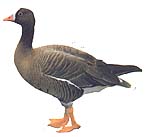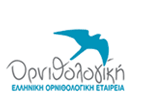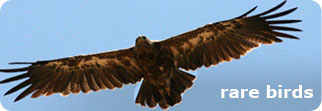 Lesser White-fronted Goose (Anser erythropus) is a small goose 53-65 cm long, with dark grey-brown plumage, and dark bars on belly. It has a small and short pink bill, its feet are orange, while wings outstrip tail’s edge when they are closed.
Lesser White-fronted Goose (Anser erythropus) is a small goose 53-65 cm long, with dark grey-brown plumage, and dark bars on belly. It has a small and short pink bill, its feet are orange, while wings outstrip tail’s edge when they are closed.
Its main characteristics are the white front rising up to the crown and the yellow eye-ring. In this way, it is distinguished from the much larger White-fronted Goose (Anser albifrons). Juveniles have also the yellow eye-ring but they lack the white forehead and the black bars on belly.
Lesser White-fronted Geese breed in a narrow zone extending from Scandinavia to the Anadyr Peninsula of NE Siberia in the Bering. Their breeding habitat is located in tundra and taiga and they feed on several plant species and, on winter, on moss.
The species winters in the Balkans, the Caspian Sea and east to China and Korea. The wintering areas in Europe are mainly found in Hungary. In the southern Balkans, Lesser White-fronted Goose winters mainly in Greece, in coastal wetlands with open fallow or arable lands, but also in inland lakes. More specifically, in our country it occurs on the Evros Delta, Lake Kerkini and Lake Mitrikoy.
It is the rarest goose of Europe (Appendix I of 79/409/EEC Directive) and it is a globally threatened species. During the 20th century the populations of Lesser White-fronted Goose were dramatically reduced at breeding sites, wintering areas and along migration zones.
From the ‘40s its population has been reduced by more than 90%. As a result, its present world population is about 50,000 individuals, 1,000 of which are wintering in Europe.
The reasons of this decline are not fully known. Habitat loss, disturbance, hunting and the intense predation in the breeding areas, cannot satisfactorily explain the strong reduction of its populations.
The most notable explanations are the loss of suitable wintering areas and intensive hunting on these areas. In any event, to give a more documented answer on this question, further information is needed for issues concerning the habits and needs of this species.
The existing data from last century show a wider distribution of the species in our country, with observations from the Spercheios Delta and Attica. In the beginning of our century it is reported as a common species in the Strymonas valley and Kerkini, while after World War II there is a marked decline for the species with the biggest counts at Evros Delta (1,630 birds on February of 1963 and 480 birds on January of 1973). In the rest of the wetlands the most significant numbers were recorded in Kerkini (70 birds on January of 1985 and 40 birds on the same month of 1974).
In Greece, the main threats are the general interventions on wetlands, mainly their conversion to arable land. Until recently, hunting was also a serious threat. While in 1993 hunting was banned for geese the situation hasn’t altered, as poaching still exists.
For the better protection of the Lesser White-fronted Goose in our country, a Life program is implemented, in order to give the best protection to its key-sites in northern Greece. Moreover, the creation of protection zones is necessary so that the birds can be left undisturbed and the populations can be monitored more efficiently. Finally, studies should be conducted for the ecology of the species and the public - especially hunters - should be informed for the importance of the species and its identification features.


 Lesser White-fronted Goose (Anser erythropus) is a small goose 53-65 cm long, with dark grey-brown plumage, and dark bars on belly. It has a small and short pink bill, its feet are orange, while wings outstrip tail’s edge when they are closed.
Lesser White-fronted Goose (Anser erythropus) is a small goose 53-65 cm long, with dark grey-brown plumage, and dark bars on belly. It has a small and short pink bill, its feet are orange, while wings outstrip tail’s edge when they are closed.
